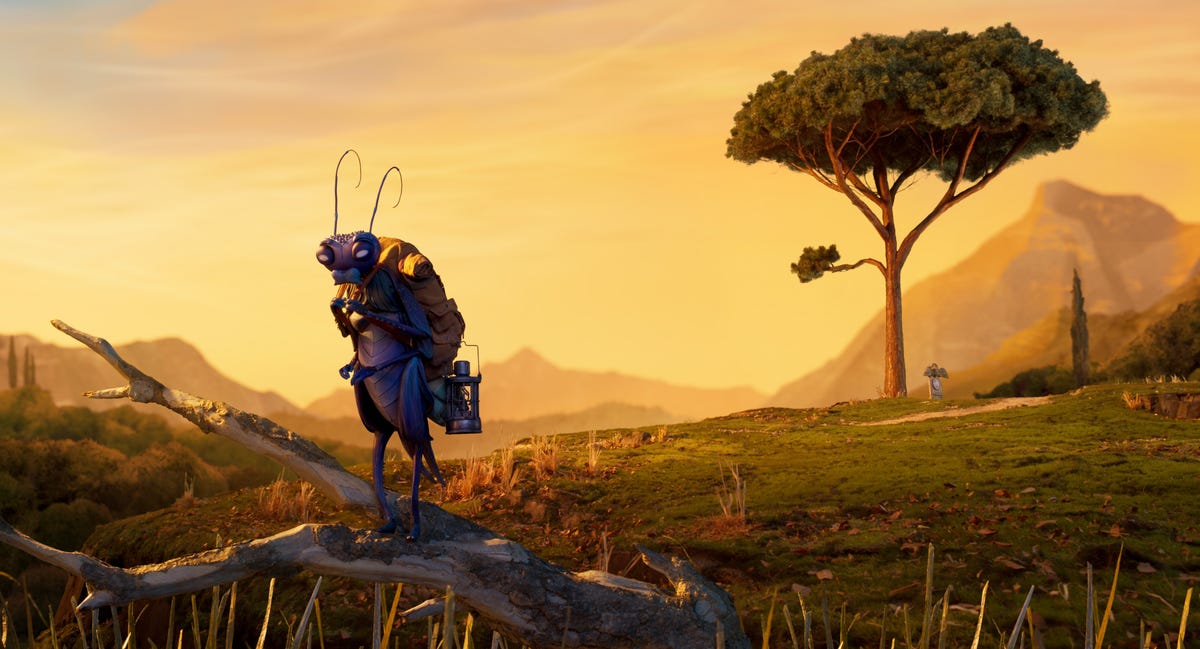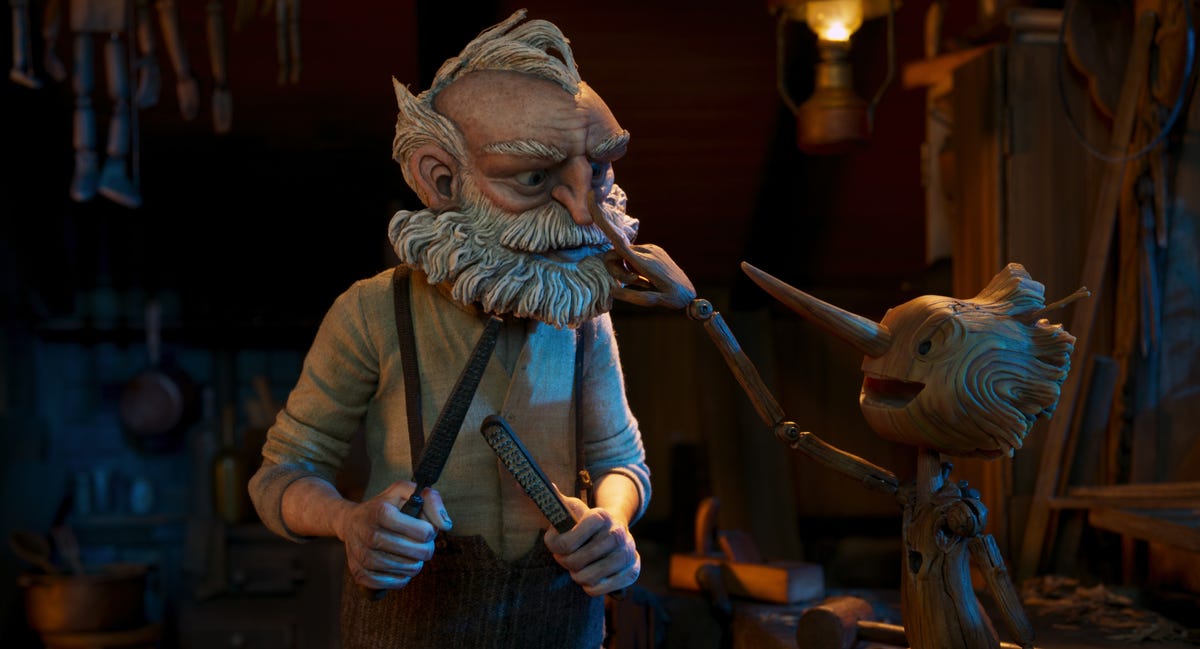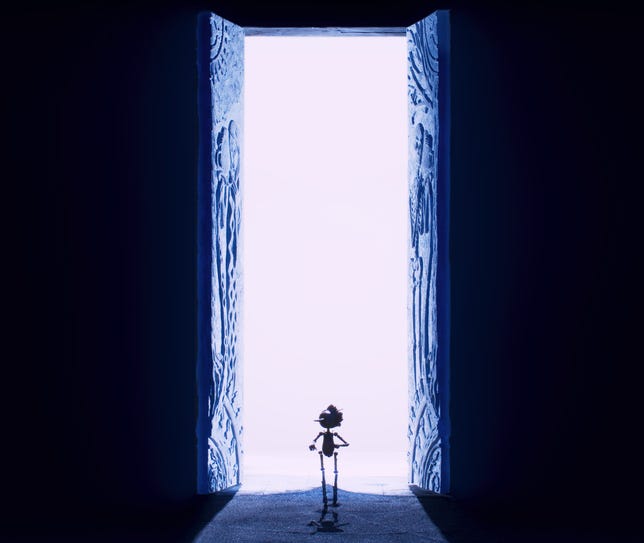Guillermo del Toro remembers seeing Walt Disney’s animated version of Pinocchio with his mom as a kid. He found the story compelling because of the frightening situations the wooden puppet, who comes to life but yearns to be a real boy, gets caught up in.
Pinocchio gets kidnapped. He is forced to perform in a traveling show. And he must rescue his “father,” the woodcarver Geppetto, from the belly of an evil whale named Monstro.
“It was the first time I saw somebody understand how scary childhood was to me,” del Toro said last month at a San Francisco showing of his version of Pinocchio at the nonprofit SFFilm’s event to honor the director’s work. “I said, ‘That’s how it feels to be a kid.'”
Decades later, the Oscar-winning director of imaginative films including Pan’s Labyrinth and The Shape of Water decided to pitch a new version of the story. It took 10 to 15 years to get funding because every major studio turned him down. He laughs when he explains why.
“I would come in and I would say it’s about death and life and the rise of Mussolini. And they would validate my parking and send me on my merry way.”
That is, until Netflix decided to greenlight del Toro’s vision for Pinocchio, which airs on the streaming service starting Friday. Del Toro thanked Netflix and other services for greenlighting TV series and movies that more traditional studios pass on.
As for Pinocchio, this version takes inspiration from the original 1883 story by Italian writer Carlo Collodi, with the setting transposed to the 1930s against the backdrop of the rise of Italian fascism.
We meet Geppetto (voiced by David Bradley) as he mourns the accidental death of his cherished son, Carlo. One night, in a wine-fueled flurry of grief and rage, Geppetto chops down a large pine tree – which happens to be the newly adopted home of a world-traveling cricket with literary aspirations – and carves it into a marionette of a young boy.
An otherworldly spirit (Tilda Swinton) takes pity on the poor old man, and, after Geppetto has fallen into bed, magically grants the puppet life. She assigns the disgruntled insect, Sebastian J. Cricket (voiced charmingly by Ewan McGregor), to be his guide and conscience.

Sebastian J. Cricket
Netflix
Even with its moments of humor and charm, this is definitely not a kid’s animated flick. When Pinocchio is introduced to the local townspeople at Sunday mass, del Toro presents a scene fittingly as bizarre as a wooden puppet coming to life would be – a counter to the Disney version where Pinocchio waltzes into town.
“I wanted him to land in the church, like a complete anomaly,” del Toro said.
A short, squat menacing Benito Mussolini also makes an appearance, arriving on screen, del Toro noted, in a Tex Avery-inspired super-stretch limo. The fascist dictator orders his henchmen to “shoot the puppet,” which sends Pinocchio into the afterlife to meet with Death.
Pinocchio actually makes several visits to the afterlife and it becomes a running joke – though it’s admittedly a bit macabre the first time it happens.
In this version of the story, Pinocchio’s arrival is far from the happily-ever-after wish granted to Geppetto. Pinocchio’s energy and enthusiasm overwhelm the bewildered woodcarver, and the marionette is more of a liability than a gift. Even when he adjusts to the fact that his puppet has a life of its own, Geppetto expresses frustration and disappointment rather than love and acceptance.
Pinocchio, after all, is not Carlo.
The film takes us far and wide – from the pair’s mountain village to a traveling carnival to a fascist training camp to, of course, the belly of a giant sea monster. But the real journey of the film is an emotional one, as both Pinocchio and Geppetto learn to accept, and love, each other. Credit is due to the young actor Gregory Mann, who voices Carlo and Pinocchio and also sings the original songs featured in the film. (Del Toro helped write some of the lyrics.)
The innovation, though, isn’t it in the story, but in how del Toro presents it. Stop-motion animation is a labor-intensive process. Shooting the film took 1,000 days. The puppets need to be moved and positioned, frame by frame. And there are 24 frames per second in this nearly 2-hour movie. Del Toro said over 60 crews working simultaneously on the production.

Geppetto and Pinocchio
Netflix
Most important, though, del Toro said his goal was to treat the animators as actors (they’re credited as such) and to show animation isn’t just a genre for kids, but an art form.
“Stop motion is the almost religious contact between the animator and the puppet,” he said. “No other medium in animation has that intimacy, that invocation, which reminds me of the form of [Japanese puppet] theater called bunraku, in which the puppet is an extension of the limbs and the emotions of the performer.”
He told the animators he wanted to feel what they felt and to see that emotion translated into the characters on the screen.

“I don’t want to see the puppet move – I want to see it animate. Animate is to give it an anima, a soul,” del Toro said. “So it is my greatest hope that you will see a completely different style of acting than you’ve ever seen in stop motion. But it is my even better hope that at some point, you will only be moved by a group of actors on the screen.”
For me at least, del Toro got his wish – even when Pinocchio becomes a “real boy” but (spoiler!) retains his wooden body rather than turning into flesh and blood. By the end of the story, I forgot the characters on screen – given life by a talented cast that includes Ron Perlman, John Turturro, Christoph Waltz and Cate Blanchett (as the monkey Spazzatura) – were animated puppets.
All that aside, the Mexican director’s take on Pinocchio will win over film fans who yearn for fewer saccharine tales and who trust that young viewers can handle the scarier stuff. Del Toro, who charmed the packed theater as he accepted SFFilm Honors for his innovation in filmmaking, said Pinocchio is a labor of love.
“What I’ve learned, the hard way, is every movie is your last movie. And if you’re given an opportunity to make a movie, there’s no reason why you shouldn’t say I’m going to make it as beautiful as I can, as perfect as I can,” he said to applause. “If I need to die [with] this movie, I will die. It’s not like I’m useful in any other arena. You give it your all every time because you never know if you’re going to shoot again. You never do.”
Guillermo del Toro’s ‘Pinocchio’ Is About Life, Death and Mussolini – CNET
Source: Media Star Philippines


0 Comments